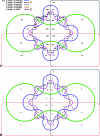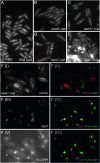Augmented annotation of the Schizosaccharomyces pombe genome reveals additional genes required for growth and viability
- PMID: 21270388
- PMCID: PMC3070528
- DOI: 10.1534/genetics.110.123497
Augmented annotation of the Schizosaccharomyces pombe genome reveals additional genes required for growth and viability
Abstract
Genome annotation is a synthesis of computational prediction and experimental evidence. Small genes are notoriously difficult to detect because the patterns used to identify them are often indistinguishable from chance occurrences, leading to an arbitrary cutoff threshold for the length of a protein-coding gene identified solely by in silico analysis. We report a systematic reappraisal of the Schizosaccharomyces pombe genome that ignores thresholds. A complete six-frame translation was compared to a proteome data set, the Pfam domain database, and the genomes of six other fungi. Thirty-nine novel loci were identified. RT-PCR and RNA-Seq confirmed transcription at 38 loci; 33 novel gene structures were delineated by 5' and 3' RACE. Expression levels of 14 transcripts fluctuated during meiosis. Translational evidence for 10 genes, evolutionary conservation data supporting 35 predictions, and distinct phenotypes upon ORF deletion (one essential, four slow-growth, two delayed-division phenotypes) suggest that all 39 predictions encode functional proteins. The popularity of S. pombe as a model organism suggests that this augmented annotation will be of interest in diverse areas of molecular and cellular biology, while the generality of the approach suggests widespread applicability to other genomes.
Figures







References
-
- Bahler, J., J. Q. Wu, M. S. Longtine, N. G. Shah, A. McKenzie, III et al., 1998. Heterologous modules for efficient and versatile PCR-based gene targeting in Schizosaccharomyces pombe. Yeast 14 943–951. - PubMed
-
- Basi, G., E. Schmid and K. Maundrell, 1993. TATA box mutations in the Schizosaccharomyces pombe nmt1 promoter affect transcription efficiency but not the transcription start point or thiamine repressibility. Gene 123 131–136. - PubMed
Publication types
MeSH terms
Substances
Grants and funding
LinkOut - more resources
Full Text Sources
Molecular Biology Databases

